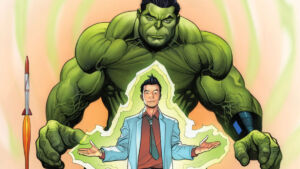Activity 5.2: How is Colonel Young Oak Kim an Unsung Hero?
Activity 5.2: How is Colonel Young Oak Kim an Unsung Hero?
Characteristics of a Hero Worksheet (PDF)
Activity 5.2: How is Colonel Young Oak Kim an Unsung Hero?
Activity Questions
- How is Young Oak Kim an unsung hero?
- Why is it important to study the stories of individuals like Young Oak Kim?
- How did Colonel Young Oak Kim make critical contributions to the Japanese American community, as well as to the progress of civil rights of all racial minority communities in the United States?
Instructional Strategies
- Use the Lesson 5: Young Oak Kim: Hero and Humanitarian (Activity 5.2) presentation to support this lesson.
 Introduction to Book
Introduction to Book
- Show the slide of Amadeus Cho, a 19-year-old Korean-American superhero in Marvel comics. Ask students to share responses to three questions:
- What is a hero?
- How is Amadeus Cho a superhero?
- What real-life heroes can you name?
- Use the slide, “What is an Unsung Hero?” to review qualities of a hero.
- Introduce the book Unsung Hero: The Colonel Young Oak Kim Story by reading the excerpt from the back cover.
- Distribute the Characteristics of a Hero Worksheet and review directions. Ask students to identify one characteristics of Young Oak Kim (based on your reading of the back cover) and help them fill in the table for that characteristic. (EX: Kim was “BRAVE” because he served in the army.)
Annotating the Text
- Provide students with one of the following:
- Excerpt from “Chapter 28: Candlelight,” Unsung Hero: The Story of Col. Young Oak Kim that includes pages 358-370.
- Young Oak Kim Biography, National Museum, U.S. Army.
- As students read the excerpt, give them the annotation chart and direct them to annotate as they read. Have them focus on his contributions to the Korean American community; the Japanese community; and communities of minorities, women, and children.
- In addition, as a prewriting activity for their biopoem, have them complete the Characteristics of a Hero worksheet. This could be done during the reading/annotation or afterwards in pairs or small groups.
Compose BioPoems
- Provide students with the BioPoem Template. Have students pair up and complete the poem.
- Have students copy biopoems onto construction or poster paper. Encourage students to draw, decorate or add photos to their biopoem.
- Post the poems around the classroom (or online) and conduct a “Gallery Walk.” Students walk around the room and view all the posters/poems. You might also give them 5-10 little star stickers to mark favorite lines in the poems.
Quick-Writes
- Provide students with the following prompt and allow them five minutes to Quick-write their response. Call on student volunteers to share their reflections.
- Note: This Quick-Writes may be used as a prewriting activity for the Argumentative Essay Summative Assessment.
- Student Prompt:
- What contributions did Colonel Young Oak Kim make to the Korean American community, Japanese American community, and the civil rights of all racial minority communities in the United States?
Closing Activity
- Use the Quick-Writes sharing to segue into a discussion on the following question as well as other discussion points and Activity Questions.
Resources
- See also Lesson 5 Teachers Guide and Presentation under Activity 5.1.
- Excerpt from “28: Candlelight,” Unsung Hero: The Colonel Young O. Kim Story, p. 358-370. (PDF)
- Website: Young Oak Kim Biography, National Museum, U.S. Army
- Young Oak Kim Biography, National Museum, U.S. Army (PDF Reprint)
- Handout: Annotation Guide
- Handout: Characteristics of a Hero
- Handout: BioPoem Template
Unsung Hero: The Col. Young O. Kim Story by Edward Chang
This book isn’t just another tale of a war hero. Kim has a special place not only in American and Korean history but also in world history. Col. Kim served in World War II and the Korean War as a minority officer leading the U.S. Army’s 100th Infantry Battalion. Kim, a Korean American, led the famous Japanese American battalion and helped bridge the racial and cultural gap between the two ethnicities. His dedication, integrity, spirit and loyalty earned him the respect of white officers in a time when racism was prevalent.
A champion of human rights, Kim believed that helping others was the best way to prevent strife and ultimately war. Kim promised himself during World War II. When he retired, Kim helped establish numerous nonprofit organizations in Los Angeles, California. He spent the rest of his retired years serving underprivileged, and minority populations such as orphans, adoptees, women and Asian Americans. (from Unsung Hero: The Colonel Young Oak Kim Story, back cover) Source: Amazon
Biopoem Template (PDF)
Annotation Guide (PDF)


